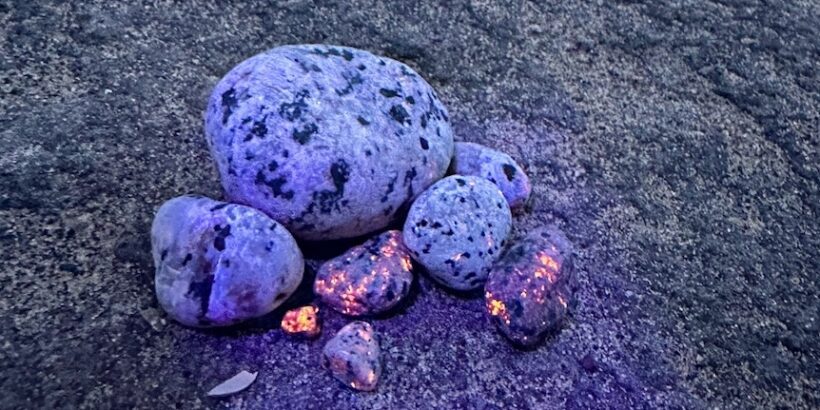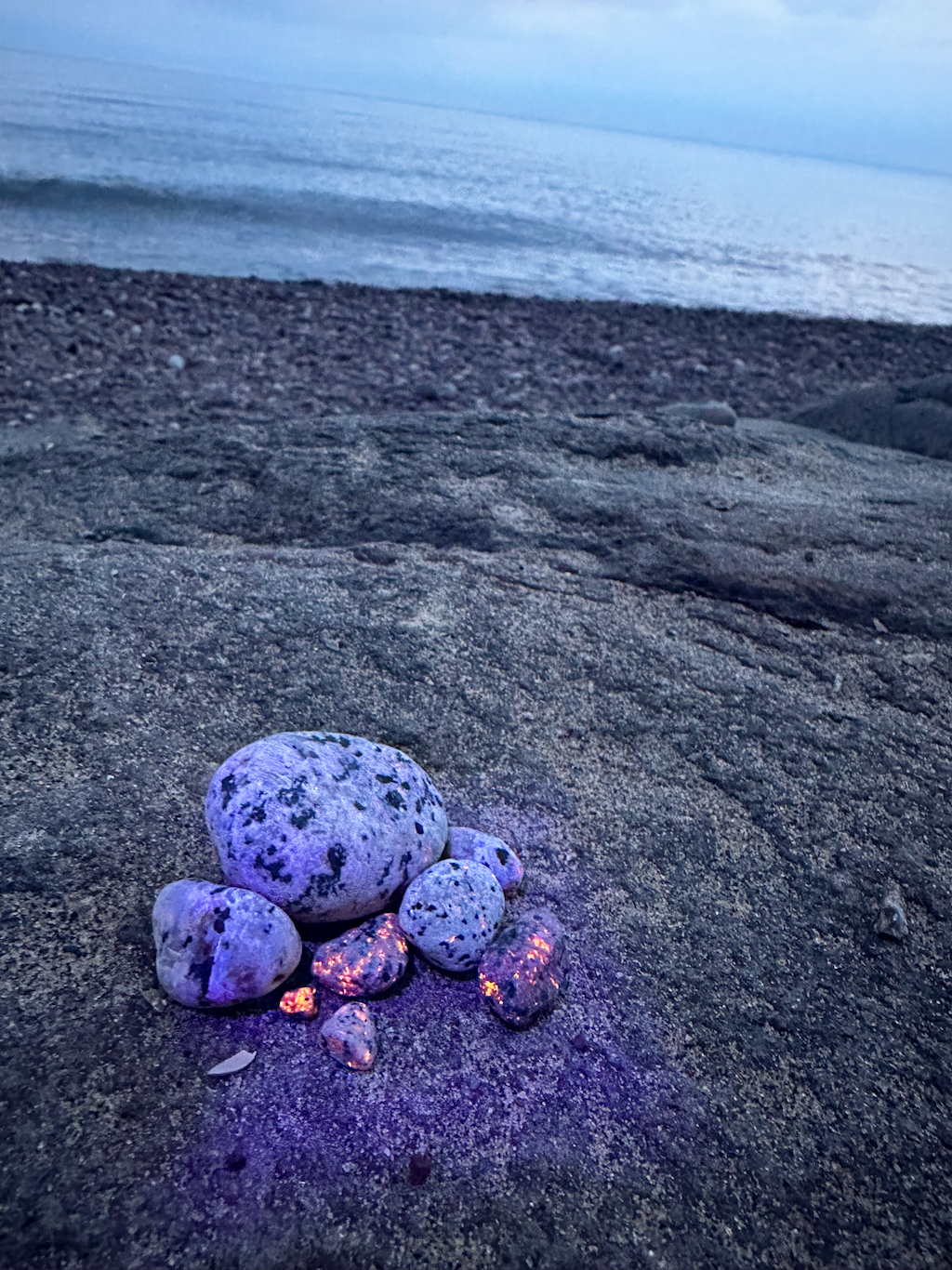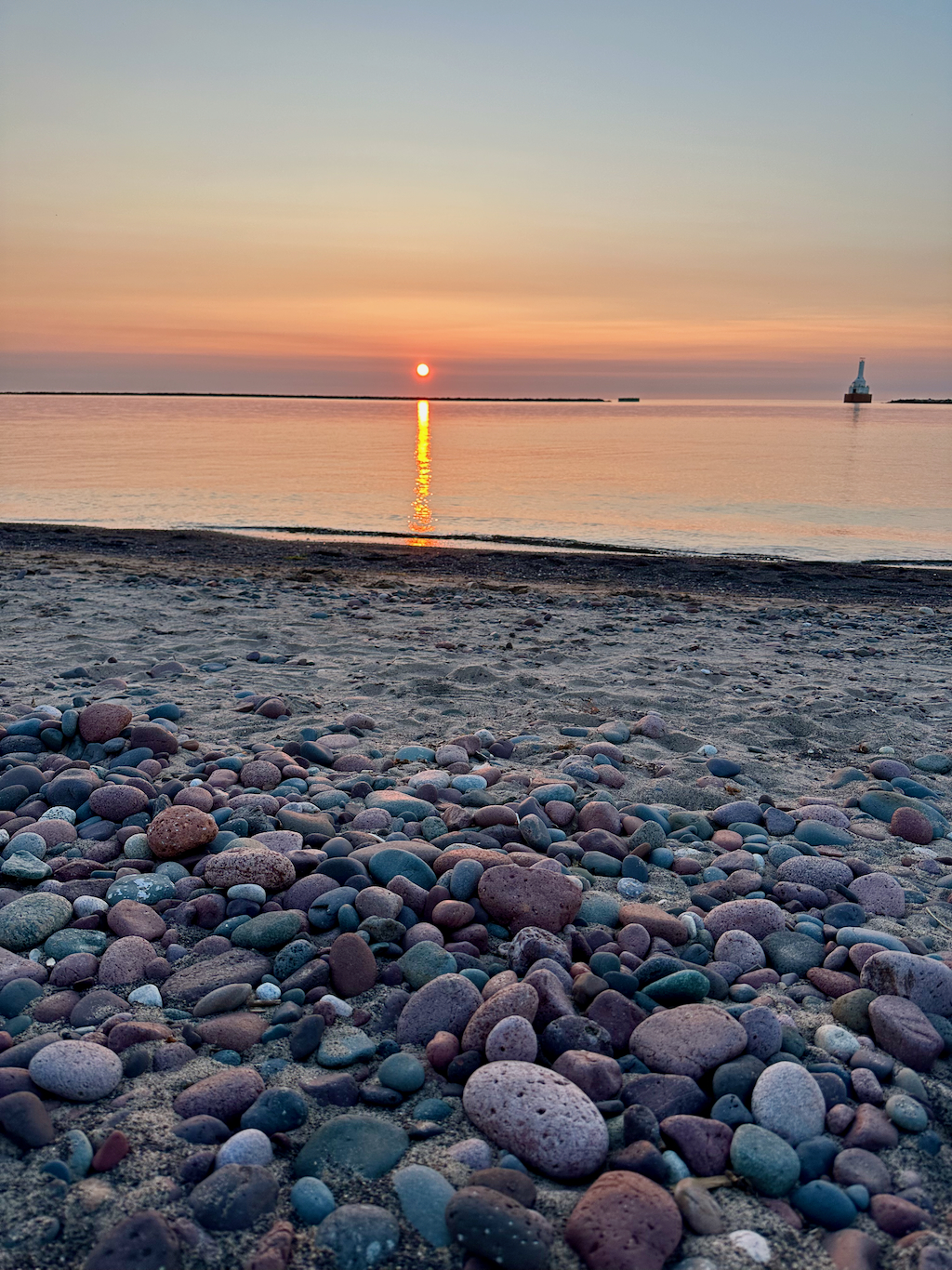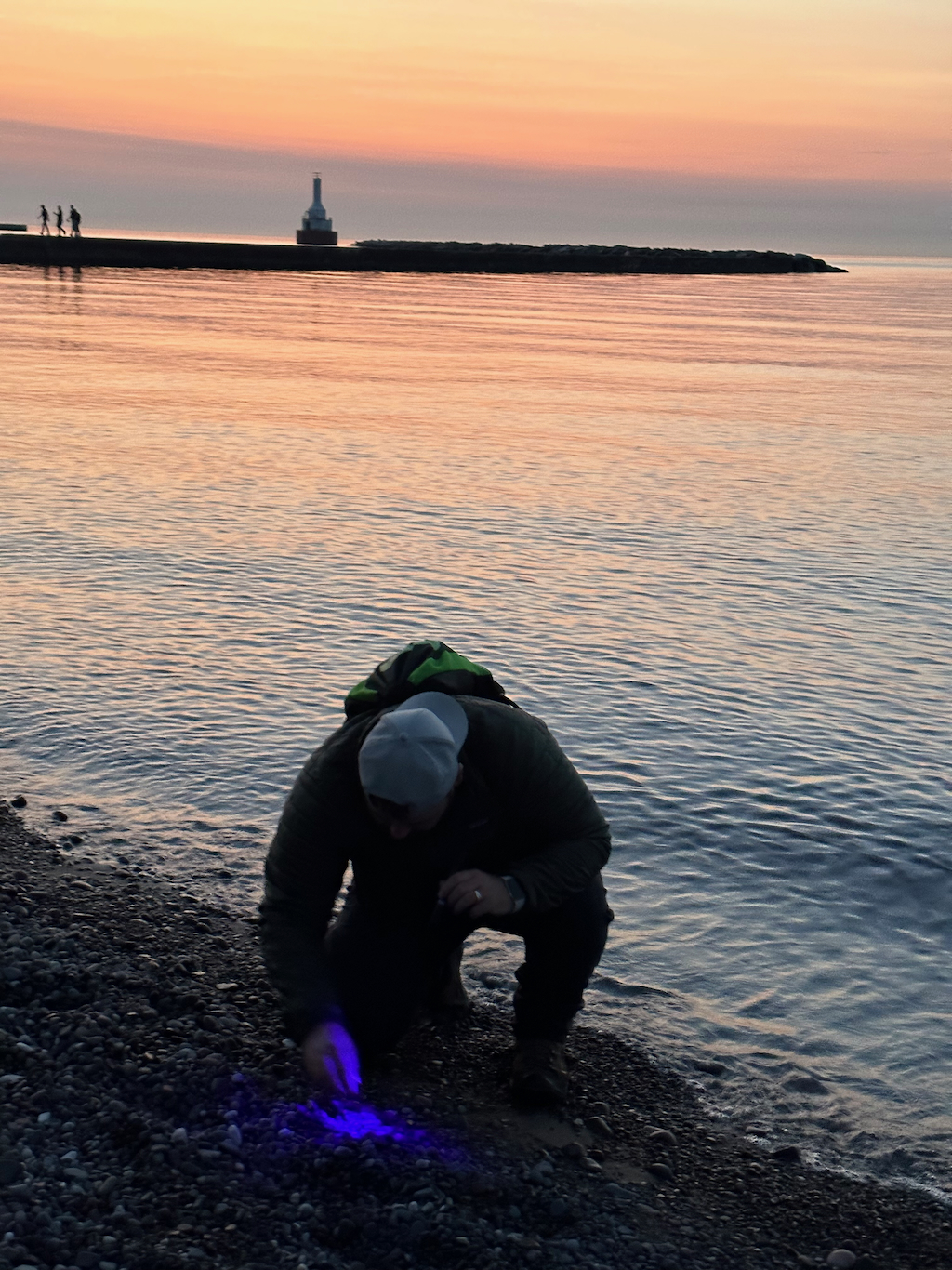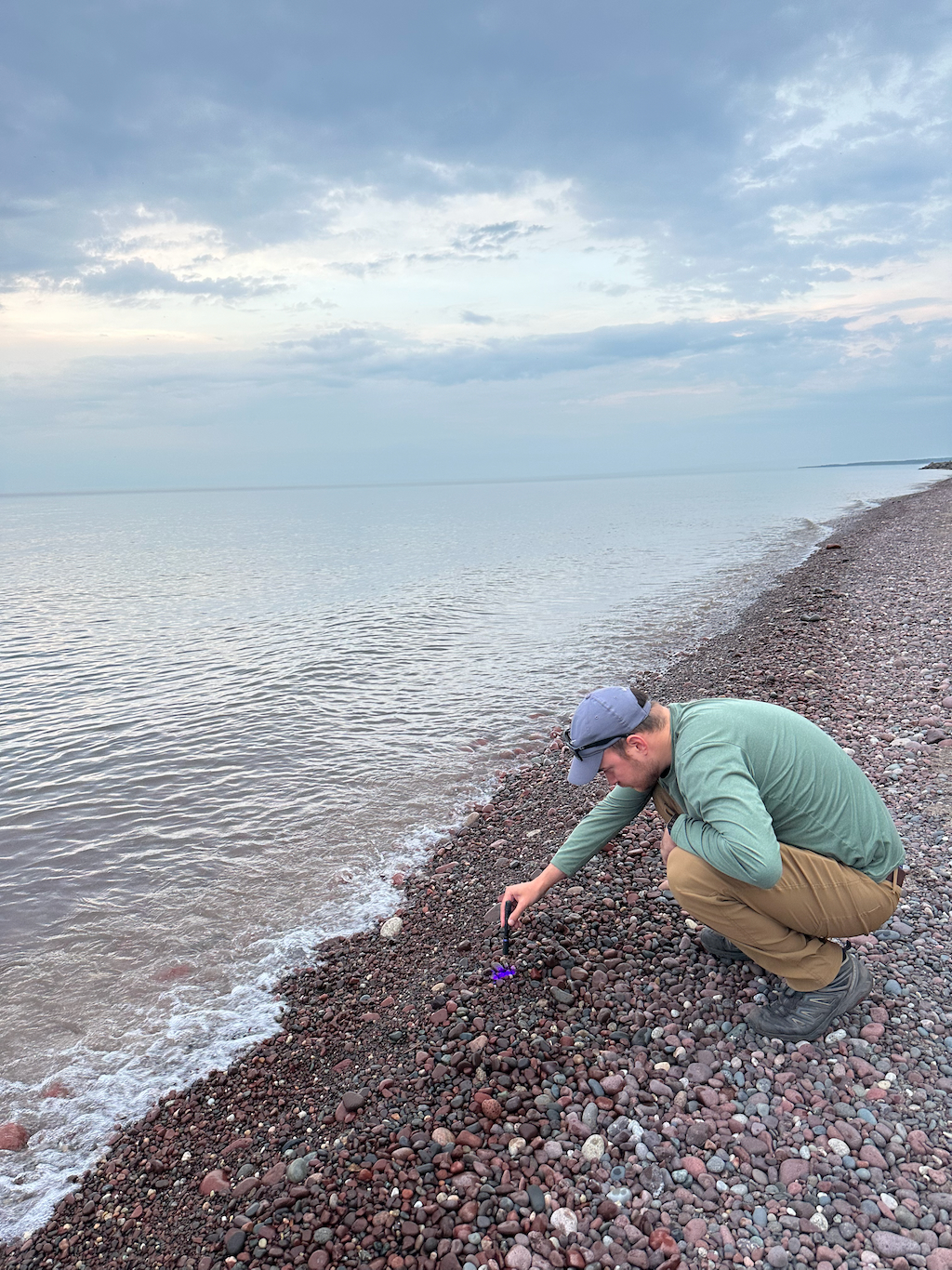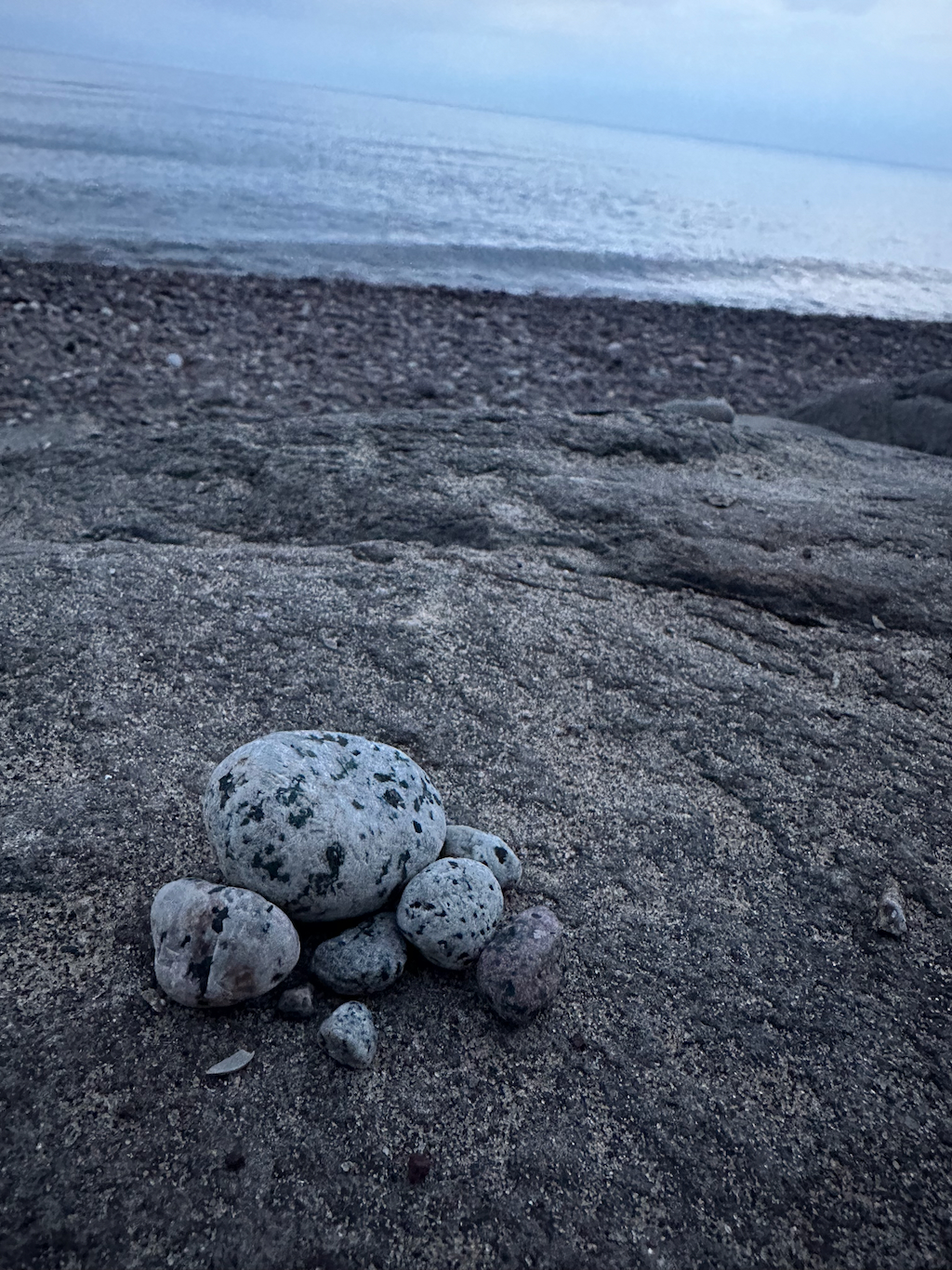If you’re planning a trip to the Upper Peninsula of Michigan or anywhere in the northern Great Lakes region, Yooperlite hunting is a highly recommended form of unique night life.
There’s an undeniable allure to these luminous rocks, and the thrill of discovering them in the wild is truly satisfying.
Below, I’ll provide you with a comprehensive guide to Yooperlites.
I’ll offer insights into their discovery, delve into their geological history, explore the luminescent components that make them unique, and also share a range of tips drawn from my personal experiences while searching for Yooperlites on the Keweenaw Peninsula.
Table of Contents
What is Yooperlite?
Yooperlite is a trademarked brand of a type of fluorescent rock that is found along the shores of Lake Superior in the Upper Peninsula of Michigan (in addition to other areas as well).
The rocks are made up of mostly syenite rock, which is similar to granite, but they contain a high concentration of fluorescent sodalite. This mineral gives the rocks their distinctive glow when exposed to ultraviolet light and makes them a prime catch for rock hounds.
Yooperlite: A brief history
Yooperlite has both a very long and very short history.
In the summer of 2017, a moment of curiosity led to an extraordinary discovery by Erik Rintamaki, a gem and mineral enthusiast hailing from Marquette, Michigan.
Armed with a UV light, he embarked on a lakeside exploration along the shores of Lake Superior. To his amazement, that fateful morning revealed a couple of rocks aglow, as if they harbored an inner molten core. In an instant, Rintamaki had unearthed a treasure previously unknown to the Michigan region.
But where did the name “Yooperlite” come from?
The nomenclature of these rocks bears a connection to the Upper Peninsula, affectionately known as “The UP.”
Within this region dwell the proud residents known as Yoopers (as in “UPers”). Thus, the initial segment of the rock’s name is a nod to these locals. The second part, “lite,” comes from the mineral “sodalite.”
Since Yooperlite is focused on the UP and these rocks do exist elsewhere, some people prefer to call them by their scientific name (Fluorescent Sodalite-bearing Syenites) or by other nicknames, such as Glowdalites.
Personally, I just like the idea of sticking with Yooperlites, because it reminds me of the UP (a place I’ve really come to love) and the UP seems to be the primary spot to find them.
Yooperlites were formed through volcanic activity approximately 1 billion years ago when the North American continent was splitting apart.
We call the event the Midcontinental Rift (or Keweenaw Rift) and it sticks out because it was the most extensive rift in Earth’s history that never evolved into an ocean.
During this time, massive amounts of lava was being produced, thousands of feet thick. Near the modern shores of Lake Superior in Ontario, a substantial body of magma was trying to breach the surface but this molten rock never made it.
Instead, it gradually cooled and solidified beneath the ground, ultimately transforming into a variety of granite known as “syenite.” This particular syenite variety had an abundance of a mineral called “sodalite,” which we will come back to in a second.
For roughly a billion years, these remarkable sodalite-filled rocks lay concealed beneath the Earth’s surface.
Then, about 10,000 years ago, the world witnessed the advent of the last ice age, with colossal ice sheets carving a dramatic path across the landscape.
In their relentless advance, these icy behemoths unearthed the Yooperlites from their ancient resting place, transporting them southward.
Ultimately, these rocks found their current abode along the shores of what would later become the Great Lakes, where they continue to be discovered and admired to this day.
So that’s how they got to Michigan but why do they glow?
Yooperlites exhibit fluorescence because of the unique properties of minerals like sodalite found within them.
When exposed to ultraviolet (UV) light, these minerals absorb the high-energy UV photons and this elevates electrons to higher energy states within the minerals.
As these excited electrons return to their lower energy states (aka rebound), they release the absorbed energy as visible light, creating the characteristic glow that Yooperlites are known for.
Where can you find Yooperlites?
People have reported finding Yooperlites in different parts of the Great Lakes region, including parts of Wisconsin and Minnesota. However, the most popular spots seem to be the Keweenaw Peninsula and areas along the north east Upper Peninsula.
Speaking with some locals, there definitely are some common hotspots people have.
From what I was told, a good Yooperlie hunter will wait until a storm rolls through that shakes everything up and brings new Yooperlite to the shore and then they will have a field day that evening. I won’t mention any of the local spots so as to not betray the friendly locals but even if you don’t know the lesser-known spots there are quite a few widely known spots to find Yooperlite.
Along the Keweenaw Peninsula you have a lot of options and we personally had luck with McLain State Park. We also tried Calumet Waterworks Park but we struck out there and I suspect some people had already cleaned house. For more locations around the Upper Peninsula, check here.
Finally, if you can’t get to the beach you can find them in rock shops. One of the easiest places to get if you are in the Houghton area is to check out the visitor center and gift shop at the Quincy Mine. They have a cool display and you can purchase them (the price depends on the size).
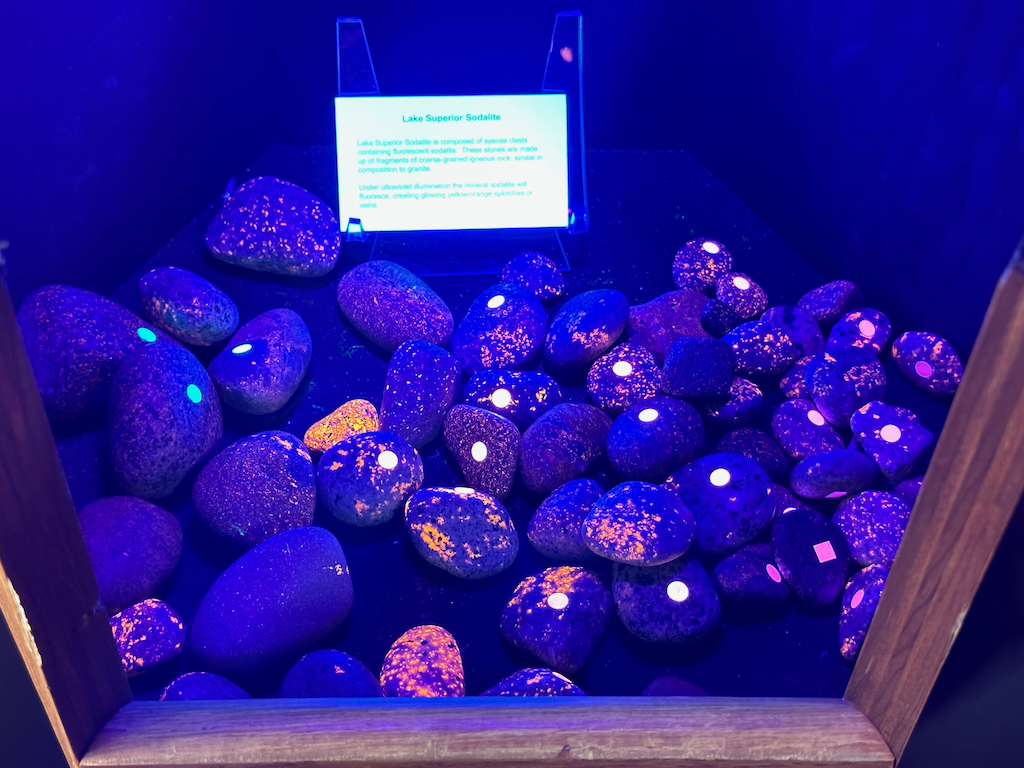
My experience finding Yooperlite (and several tips)
Arriving early can be worth it if you have a good light
We typically reached the beach approximately 20 minutes before sunset, and it wasn’t uncommon to spot one or two fellow enthusiasts already engaged in their quest.
Prior to sunset, if equipped with a sufficiently powerful black light, Yooperlites are certainly discoverable, albeit with a higher level of difficulty.
Discovering your first Yooperlite — as you witness a seemingly ordinary stone transform into a radiant spectacle — is an unforgettable experience and instantly addictive.
On our first outing, we found ourselves dedicating a solid hour or so to the pursuit, although it’s entirely possible we could have continued for much longer if we didn’t have other plans that evening, such as hunting for the northern lights.
You can still find them if trailing behind people
Even if you’re trailing behind someone, following in their footsteps, there’s still a good chance of making substantial finds.
It’s a challenging task for anyone to meticulously examine and search through all of the thousands upon thousands of rocks, so you’ll likely to still be able to find something.
A 365 nm UV light is preferable but you can still get by with a 395 nm
The prevailing advice often suggests that a 365 nm UV light is notably superior to a 395 nm one for Yooperlite hunting. Personally, I found myself favoring the 365 nm UV flashlight, primarily due to the enhanced glow of the rocks.
However, during my “time in the field,” I didn’t observe a substantial disparity in terms of detecting Yooperlites when using either the 395 nm or the 365 nm UV light.
In both cases, I could readily discern the sparkling specks of glowing sodalite.
It’s very likely that the quality of my 365 nm flashlight was not optimal (it was like $15), but it’s reassuring to know that a 395 nm black light can still effectively illuminate Yooperlites.
Which ever way you go, make sure you have an extra set or two of batteries so that you can continue on through the night, especially if you’re having a lot of good luck.
A rock scooper and more powerful UV light will make the hunt less physically demanding
I found myself quite fatigued (and lightheaded) from constantly crouching and getting up during our Yooperlite hunts.
Our use of small black lights forced me to get up close to the rocks, and the absence of a rock scooper further added to the effort.
Many other rockhounds on the beach were equipped with more potent black lights and rock scoopers, sparing them from the need to frequently bend over.
If you’re truly committed to spending ample time searching for Yooperlites, I recommend investing in these tools, as it appeared to make the process significantly more efficient and less physically demanding.
Be prepared to find some weird stuff
With your UV light, you’ll find more than just Yooperlite.
You will notice that some rocks also have a certain glow about them although it’s different from the orange glow of the sodalite.
You also might come across trash and random discarded oddities.
You can use this as an opportunity to help clean up the shore but also be mindful of the things you might be grabbing with your hand as you may not want to come into contact with certain things. For example, I came across a random Q-tip.
Take a note of where your turn off on the beach is
You’re going to be wandering around at night but luckily, it’s pretty easy to navigate as you’re just walking along the shoreline, probably in one direction and then coming back. It would be hard to get truly “lost” but it’s possible you could struggle to find your turn off point back to the parking lot.
I’ve heard of people using glow sticks to mark the turn off point which could be helpful if you’re somewhere that’s tricky to identify. However, we were able to usually just note a large stone or driftwood that helped us remember where to go.
It will also be helpful to have a regular white light or red light to help you navigate when not using your black light (headlamps are also handy).
Hiking boots are a good choice
We opted to don hiking boots with waterproof capabilities, enabling us to position ourselves where the waves washed up on shore. This placed us in proximity to what’s likely the most abundant collection of stones, as it represents the freshest deposit of rocks at any given time.
I’ve also come across stories of individuals wading into the water during their Yooperlite quests, so the approach can vary depending on your level of dedication and adventure-seeking spirit.
Hiking boots also help you better navigate the rocky shores which could be tougher with thin tennis shoes.
Bring a bag
You’ll definitely want a dependable bag to keep all your discovered rocks secure, as Yooperlite hunting can yield quite a collection. This is also where you can keep some snacks and water as you’ll be surprised how quickly you can work up some thirst and an appetite hunting for rocks.
Check up on the law
At the time of this post, it looks like Michigan law allows you to collect up to 25 pounds of rocks per year from state parks but make sure you verify the legality of what you’re doing. Some sites (like Pictured Rock National Lakeshore) may not allow rock collecting and you also need to be careful about stepping onto private property.
Wear extra layers
There’s a good chance it will get cold when out there so having extra layers is good. On one night we went out it wasn’t bad at all. Still, I always like having a puffer jacket when heading out to a lakeshore like this at night because you never know what the wind is going to be capable of.
Look for patterns in the rocks
We noticed a striking similarity among most of the rocks we encountered – a gray appearance with black speckles. So one effective strategy is to concentrate on rocks that resemble the ones you’ve already gathered, although it’s worth noting that there can be variability with these rocks.
Final word
Our Yooperlite hunt was undoubtedly one of the highlights, no pun intended, of our time in the Upper Peninsula.
It’s one of those peculiar discoveries that unexpectedly becomes quite addictive. If I lived in this area, I could easily see myself making it a regular pastime.
There are no doubt some spots that are hotspots, not because they receive an extra deposit of these rocks but because only seasoned enthusiasts know how to access and uncover them. But there are also many well-known beaches along the coast in the Keweenaw Peninsula that seem like a good spot for the average newcomer.
I hope the wealth of information and tips provided in this article will equip you to fully appreciate, enjoy, and ultimately build your own collection of these fascinating stones when you explore the Upper Peninsula of Michigan!
Daniel Gillaspia is the Founder of UponArriving.com and the credit card app, WalletFlo. He is a former attorney turned travel expert covering destinations along with TSA, airline, and hotel policies. Since 2014, his content has been featured in publications such as National Geographic, Smithsonian Magazine, and CNBC. Read my bio.

